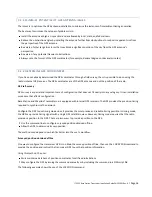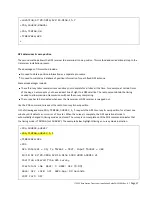
ITC 220 Base Station Transceiver Installation Guide PN 133991 Rev. A
| Page 31
APPENDIX A
— ABBREVIATIONS AND DEFINITIONS
A:
Ampere, or Amp; measure of electric current
AWG:
American Wire Gauge (a measure of wire
diameter)
BER:
Bit Error Rate
CIM:
Configuration Interface Module
cm:
Centimeter
Common Channel:
A CSMA-operated channel common
to all Base Station, Locomotive, and Wayside
Transceivers in the system. Every radio transceiver in
the system should have the same common channel.
CSMA:
Carrier Sense Multiple Access
CW:
Constant Wave
dB:
Decibel
dBd:
Decibel, dipole
dBi:
Decibel, isotropic
dBm:
Decibel, referenced to one milliwatt
DC:
Direct Current
DCE:
Data Communication Equipment
DTDMA:
Dynamic Time Division Multiple Access
DOP
Dilution of Precision
DQPSK:
Differential Quaternary Phase-Shift Keying
EIA:
Electronic Industries Alliance
EIRP:
Equivalent Isotropically Radiated Power
ERP:
Effective Radiated Power
EVM:
Error Vector Magnitude
FCC:
Federal Communications Commission (U.S.)
FRA:
Federal Railroad Administration (U.S.)
FTDMA:
Fixed Time Division Multiple Access
GPS:
Global Positioning System
HAAT:
Height Above Average Terrain
IC:
Industry Canada
ITC:
Interoperable Train Control
ITCR:
Interoperable Train Control Radio
kbps:
Kilobits per Second
LAN:
Local Area Network
LOS:
Line of Sight
Local Channel:
A frequency assigned to each Base
Transceiver (DTDMA and FTDMA) and Wayside
Transceiver (FTDMA)
m:
Meter
Mbps:
Megabits Per Second
MEO:
Medium Earth Orbit
MHz:
Megahertz
MPE:
Maximum Permissible Exposure
MSGPS:
Multi-Satellite Global Positioning System
mW:
Milliwatt
NIC:
Network Interface Card or Network Interface
Controller
OCXO:
Oven-Controlled Crystal Oscillator
PC:
Personal Computer
PCA:
Printed Circuit Assembly
PCB:
Printed Circuit Board
PEP:
Peak Envelope Power
PER:
Packet Error Rate
POST:
Power On Self Test
PPM:
Parts Per Million
















































